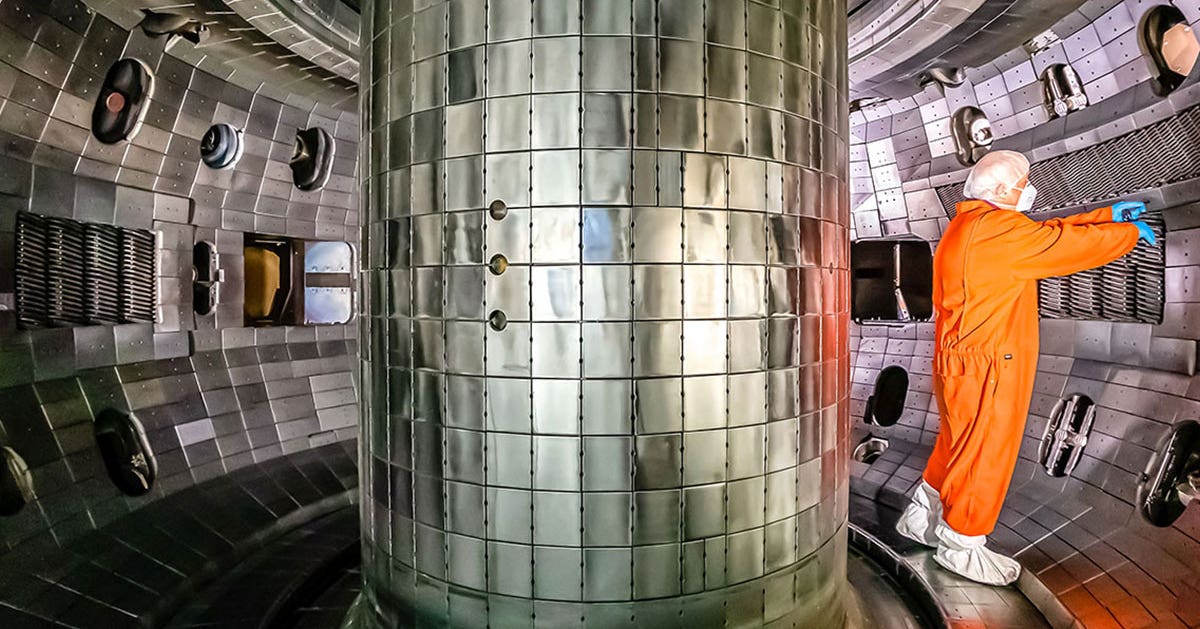Nuclear fusion breakthrough brings endless energy closer to reality
Researchers at General Atomics have unveiled a key advance in nuclear fusion, the same process that fuels the sun.

A technician operates within a tokamak at the General Atomics research facility located in San Diego, California. (CREDIT: CC BY-SA 4.0)
Researchers have made a leap forward in the pursuit of clean, endless energy. A team at General Atomics, a U.S. Department of Energy-backed facility, has unveiled a key advance in nuclear fusion, the same process that fuels the sun.
The results, published in Nature, mark a milestone in turning fusion technology into a real-world energy source. For decades, scientists have aimed to harness this power, but major technical obstacles stood in the way.
Overcoming the Hurdles to Achieve Fusion Energy
Fusion works by fusing atomic nuclei under extreme heat and pressure. Unlike current nuclear reactors, which split atoms, fusion promises massive energy yields without long-lived radioactive waste.
To make fusion happen, researchers must create and sustain a state of matter called plasma. This searing-hot mix of charged particles must reach temperatures of hundreds of millions of degrees Celsius—hotter than the sun's core.
At those conditions, atomic nuclei collide and fuse, releasing tremendous energy. But the hard part isn’t just creating plasma. It’s keeping it stable and contained long enough to extract power.
Tokamak reactors are the top contender in this race. These doughnut-shaped machines use strong magnetic fields to keep plasma confined. Yet they face a critical limit: how dense the plasma can get without becoming unstable.
What the Greenwald Limit Means for Fusion Energy
This cap is known as the Greenwald limit, after physicist Martin Greenwald. Go beyond it, and plasma begins to wobble, disrupting the reaction and cutting off energy production.
Related Stories
It’s a hard ceiling fusion scientists have battled for years. Overcoming it could unlock steady, high-output fusion—bringing us closer to a world powered by clean and nearly limitless energy.
In tokamak reactors, this limit has been a persistent obstacle because, beyond a certain density, the plasma becomes unstable, leading to energy loss or potential damage to the reactor. The inability to exceed the Greenwald limit without significant consequences has posed a challenge for creating a fusion reactor that could operate efficiently and continuously.
Breaking Through the Limit
The General Atomics research team has now managed to overcome this barrier. Their experiment produced stable plasma with a density that is 20% higher than the Greenwald limit. Not only did they achieve this higher density, but they also maintained a plasma confinement quality that was 50% better than the standard high-confinement mode typically used in tokamak reactors.
This breakthrough is significant because it addresses a major bottleneck for commercial fusion reactors. Many tokamak designs require plasma densities higher than the Greenwald limit to achieve efficient fusion.
Previous attempts to exceed this limit often resulted in reduced plasma confinement or complete loss of energy. The success of the General Atomics team in achieving both high density and strong confinement opens up new possibilities for designing more efficient and reliable fusion reactors.
Managing Plasma Instabilities
Another major hurdle in fusion reactors like tokamaks is controlling the instabilities that can develop within the plasma. These instabilities, if left unchecked, can disrupt the reactor's operations and damage its components. The recent findings from General Atomics not only surpassed the Greenwald limit but also hinted at potential methods for managing these instabilities.
The researchers noted a "synergy" between achieving high plasma density and maintaining high confinement, which could lead to a more stable state for the plasma. This suggests that it may be possible to achieve conditions where the plasma remains stable even at higher densities, reducing the risk of disruptions that have previously been a major challenge.
Balancing Temperatures in the Plasma
Fusion reactors also face the challenge of balancing temperatures within the plasma. To initiate fusion, the core of the plasma must be extremely hot—reaching hundreds of millions of degrees Celsius—while the outer edge, which comes into contact with the reactor walls, needs to be kept much cooler to prevent damage. Achieving and maintaining this balance is crucial for the reactor's efficiency and longevity.
The research from General Atomics provides new insights into how to manage this temperature gradient effectively. Understanding the physics that govern the temperature distribution within the plasma can help in designing reactors that are both compact and efficient. These insights bring researchers closer to solving one of the critical engineering challenges that have held back the development of practical fusion power.
The breakthrough by the General Atomics team represents a significant step towards achieving commercially viable fusion power. By breaking through the Greenwald limit and demonstrating improved plasma confinement, they have unlocked new opportunities for more efficient fusion energy production.
This development could pave the way for the creation of fusion reactors that are capable of operating under conditions necessary for sustained and efficient power generation.
While there is still much work to be done before fusion power becomes a reality, the progress made by these researchers is a clear indication that we are moving in the right direction.
Achieving stable, high-density plasma in a controlled environment is one of the key milestones on the path to fusion energy, and the recent advances are an encouraging sign that the dream of clean, limitless energy may one day become a reality.
Key Takeaways
- Nuclear fusion is a promising source of clean and sustainable energy, but creating and maintaining the conditions for fusion is extremely challenging.
- Tokamak reactors use magnetic fields to confine the hot plasma needed for fusion, but plasma density is limited by the Greenwald limit, beyond which instabilities disrupt confinement.
- Researchers at General Atomics have successfully surpassed the Greenwald limit, achieving plasma density 20% higher while maintaining superior confinement.
- This breakthrough addresses a major obstacle for fusion reactors, making it possible to achieve conditions required for efficient fusion.
- The research also provides insights into managing plasma instabilities and balancing core and edge temperatures, critical for reactor efficiency.
- These advancements mark a significant step towards the realization of commercially viable fusion power.
Note: Materials provided above by The Brighter Side of News. Content may be edited for style and length.
Like these kind of feel good stories? Get The Brighter Side of News' newsletter.



